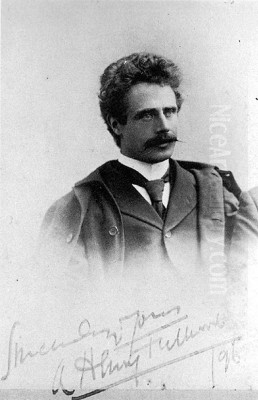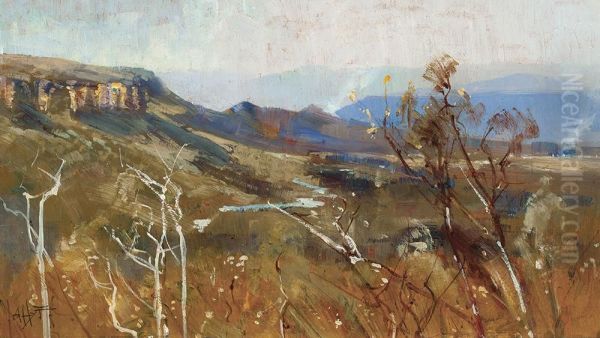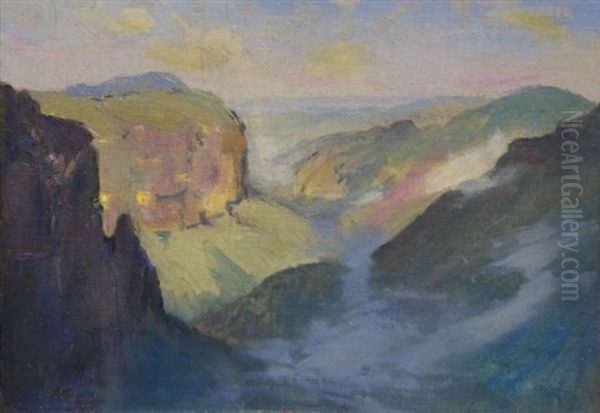A Dual Identity: British Roots, Australian Artistry

Albert Henry Fullwood stands as a significant, albeit sometimes overlooked, figure in the annals of Australian art history. Born in Hockley, Birmingham, England, on March 15, 1863, his origins were firmly planted in the industrial heartland of Victorian Britain. However, his artistic legacy is inextricably linked with the landscapes, life, and historical moments of Australia, the country he adopted and depicted with such dedication. Fullwood's career traversed the realms of illustration, printmaking, Impressionist landscape painting, and official war art, making him a versatile and prolific contributor to the visual culture of his time.
His initial training occurred at the Birmingham Institute, equipping him with the foundational skills that would serve him throughout his diverse career. Like many young Britons of his era, the allure of the colonies, with their promise of opportunity and new horizons, proved strong. In 1883, at the age of 20, Fullwood made the pivotal decision to immigrate to Sydney, Australia, a move that would define the trajectory of his professional life and artistic output. He arrived at a time when Australia was forging its own cultural identity, and artists played a crucial role in interpreting and representing the continent to itself and the world.
The Illustrator's Eye: Documenting a Developing Nation
Upon arriving in Sydney, Fullwood quickly established himself within the city's burgeoning publishing industry. His skills in drawing and printmaking were highly sought after. He initially found work as a lithographic draftsman and designer. One of his most significant early commissions was for the ambitious publication, The Picturesque Atlas of Australasia (published 1886-1888). This landmark project aimed to capture the essence of the Australian colonies through detailed illustrations and descriptive text.
Working alongside other prominent artists like Julian Ashton, Frank P. Mahony, and William Macleod, Fullwood contributed numerous illustrations to the Atlas. His work involved travelling to various locations, sketching scenes of urban life, rural landscapes, and notable landmarks. This experience not only honed his observational skills but also deepened his familiarity with the Australian environment. His contributions helped shape the visual narrative of the nation presented in this influential publication.

Beyond the Atlas, Fullwood became a regular contributor to popular illustrated newspapers and magazines of the day. He worked extensively for the Australian Town and Country Journal, The Bulletin, and the Illustrated Sydney News. His versatility was evident as he produced not only topographical views and depictions of daily life but also cartoons, often under the pseudonym "Remus." This work required speed, accuracy, and an ability to capture the essence of a scene or event for a mass audience, skills that complemented his later fine art practice. His illustrations played a vital role in disseminating images of Australia both domestically and internationally, contributing to the visual understanding of the colony in the late 19th century.
Embracing the Light: Fullwood and Australian Impressionism
While maintaining his successful career as an illustrator, Fullwood was increasingly drawn to painting, particularly the burgeoning Impressionist movement that was taking root in Australia. He became associated with the artists of what would become known as the Heidelberg School, the movement most synonymous with Australian Impressionism. Though primarily based in Melbourne, the influence of this school, with its emphasis on plein air (outdoor) painting and capturing the unique effects of Australian light and atmosphere, resonated strongly in Sydney as well.
Fullwood formed close associations with key figures of the movement, most notably Tom Roberts and Arthur Streeton. During the 1890s, he frequently joined them at artists' camps established around Sydney Harbour. The most famous of these was the Curlew Camp, located on the shores of Little Sirius Cove, near Mosman. Here, artists lived and worked communally, immersing themselves in the landscape and experimenting with Impressionist techniques.
Living and painting alongside Roberts and Streeton proved immensely influential. Fullwood embraced the Impressionist ethos, focusing on capturing fleeting moments, the interplay of light and shadow, and the vibrant colours of the Australian bush and harbour. His brushwork became looser, his palette brightened, and his focus shifted towards subjective experience rather than purely topographical accuracy, although his strong drafting skills always underpinned his work. He shared artistic camaraderie not only with Roberts and Streeton but also with others in the Sydney art scene like Charles Conder (though Conder's main association was with the Melbourne group earlier) and Julian Ashton, who was a significant teacher and advocate for plein air painting.
Capturing the Landscape: Representative Works

Fullwood's engagement with Impressionism resulted in some of his most celebrated works, primarily landscapes that captured the beauty of the Sydney region and beyond. One of his most iconic paintings from this period is View from Balmoral (sometimes referred to as Balmoral View or similar titles, c. 1895). This work, depicting the scenic outlook across Sydney Harbour from the Mosman area, exemplifies his Impressionist style. It showcases his ability to render the hazy, light-filled atmosphere of the harbour, using broken brushwork and a subtle colour palette to convey the heat and tranquility of the scene. It reflects the shared artistic concerns of the Curlew Camp artists.
His explorations were not limited to the harbour. Fullwood was also captivated by the unique landscapes of the Blue Mountains, west of Sydney. Works such as Kanimbla Valley (c. 1890) and Over the Hills and Far Away (Blue Mountains) demonstrate his skill in capturing the vastness, the distinctive blue haze, and the dramatic geological formations of this region. He often employed watercolour for these scenes, showcasing his mastery of this medium alongside his work in oils.
Fullwood also turned his Impressionist eye to urban scenes. Collins Street at Dusk (c. 1890), likely painted during a visit to Melbourne, captures the bustling energy of the city street as evening descends. The wet pavements reflecting gaslight, the blurred movement of figures and carriages, all rendered with atmospheric sensitivity, show his alignment with the broader Impressionist interest in modern urban life, echoing works by artists like Camille Pissarro or Childe Hassam internationally, and closer to home, the urban scenes of Roberts himself. His versatility extended to printmaking, where he produced etchings and lithographs that translated his landscape visions into graphic form, often with a delicate linearity and atmospheric tone. In 1903, he also produced a series of postcards featuring views of the Jenolan Caves, further demonstrating his engagement with popularizing Australian scenery.
A Shift in Focus: London and Return
Around the turn of the century, seeking broader horizons and international recognition, Fullwood travelled to London in 1900. He spent nearly two decades based primarily in England and Europe, though he maintained connections with Australia. During this period, he exhibited his work at prestigious venues, including the Royal Academy of Arts in London and the Société des Artistes Français (the Paris Salon). This international exposure brought him recognition beyond Australian shores.
While in London, he became a member of the Chelsea Arts Club, associating with British and expatriate artists. His work during this period continued to include landscapes, but he also engaged with different subjects and possibly absorbed influences from contemporary British art movements, perhaps encountering the work of artists like Philip Wilson Steer or Walter Sickert, though his core style remained rooted in his Australian experiences. He continued to work as an illustrator and printmaker, finding outlets for his talents in the competitive London art market. His success is evidenced by his winning the Wynne Prize for watercolour in 1904 for a work titled The Station Boundary, awarded during a visit back to Australia.
The War Artist: Documenting the Great War
The outbreak of the First World War dramatically shifted Fullwood's focus. Despite being in his early fifties, an age well beyond typical enlistment, his patriotism and desire to contribute led him to serve. In 1915, he enlisted in the Allied Expeditionary Force and served with the Royal Army Medical Corps (RAMC), initially working in administrative roles and later assisting with surgical dressings at the 3rd London General Hospital. His artistic skills were soon recognized.
In 1918, Fullwood was appointed as an official Australian war artist, attached to the 5th Division of the Australian Imperial Force (AIF) on the Western Front, holding the rank of Honorary Lieutenant. This role placed him alongside other notable Australian war artists such as George Lambert, Arthur Streeton (who also served as a war artist), Will Dyson, and H. Septimus Power. His task was to document the experiences of Australian soldiers, the landscapes of the battlefields, and the machinery of war.
Fullwood produced a significant body of work during this period, primarily watercolours and drawings. Unlike some war artists who focused on the heat of battle, Fullwood often depicted the quieter, everyday aspects of military life: soldiers at rest, field kitchens, billets in ruined French villages, communication trenches, and the scarred landscapes of France and Belgium. His works possess a poignant, observational quality, capturing the atmosphere of the front lines and the resilience of the soldiers with sensitivity and detail. His background as an illustrator likely contributed to his ability to quickly capture scenes and details effectively. These works form an invaluable part of Australia's visual record of the war, housed primarily in the collection of the Australian War Memorial in Canberra.
Later Years and Legacy
After the war, Fullwood spent a brief period in London before returning permanently to Sydney in 1920. He resumed his place in the Sydney art scene, continuing to paint and exhibit. He remained an active member of the Society of Artists and was respected as a senior figure in the Australian art world. He continued to paint landscapes, often revisiting familiar locations around Sydney Harbour and the countryside, his style retaining its Impressionist roots while perhaps showing a more mellowed, reflective quality in his later years.
Albert Henry Fullwood passed away in Sydney on October 1, 1930. His legacy is that of a highly skilled and versatile artist who made significant contributions across multiple fields. As an illustrator, he helped shape the visual identity of late colonial Australia through widely circulated publications. As a painter, he was an important participant in the Australian Impressionist movement, working alongside its leading figures like Roberts and Streeton, and contributing iconic images of the Australian landscape that resonated with the nationalistic sentiments of the era, alongside contemporaries like Frederick McCubbin and Walter Withers.
His role as an official war artist provided a crucial visual record of Australian experiences during the First World War, offering a unique perspective focused on the human element amidst the conflict. While perhaps not achieving the same level of enduring fame as Roberts or Streeton, Fullwood's work is held in major Australian public collections, including the National Gallery of Australia, the National Gallery of Victoria, the Art Gallery of New South Wales, the Australian War Memorial, the National Library of Australia, and the Mosman Art Gallery, which holds particular significance given his association with the Curlew Camp.
His collaborations extended beyond the Heidelberg School; his work on the Picturesque Atlas placed him alongside Ashton, Mahony, and Macleod, while his war service connected him with Lambert and Dyson. His early work for publications like The Bulletin connected him to the graphic arts tradition that included artists like Livingston Hopkins ("Hop") and Phil May. His participation in the broader art scenes in Sydney and London brought him into contact with countless other artists, including members of the Society of Artists in Sydney like Dattilo Rubbo or Lister Lister, and potentially figures within the Chelsea Arts Club network in London.
Conclusion: A Versatile Chronicler
Albert Henry Fullwood's career reflects the dynamic nature of Australian art at a formative period. He successfully navigated the demands of commercial illustration, embraced the revolutionary aesthetics of Impressionism, and answered the call to document national history during wartime. His British birth and training provided a foundation, but his artistic identity was forged under the Australian sun, amidst its unique landscapes and alongside its pioneering artists. From the detailed engravings for the Atlas to the light-filled canvases of Sydney Harbour and the poignant watercolours from the Western Front, Fullwood consistently demonstrated technical skill, keen observation, and a deep engagement with his subject matter. He remains a key figure for understanding the breadth of artistic practice in Australia from the late 19th century through the early 20th century, a chronicler of a nation finding its visual voice.